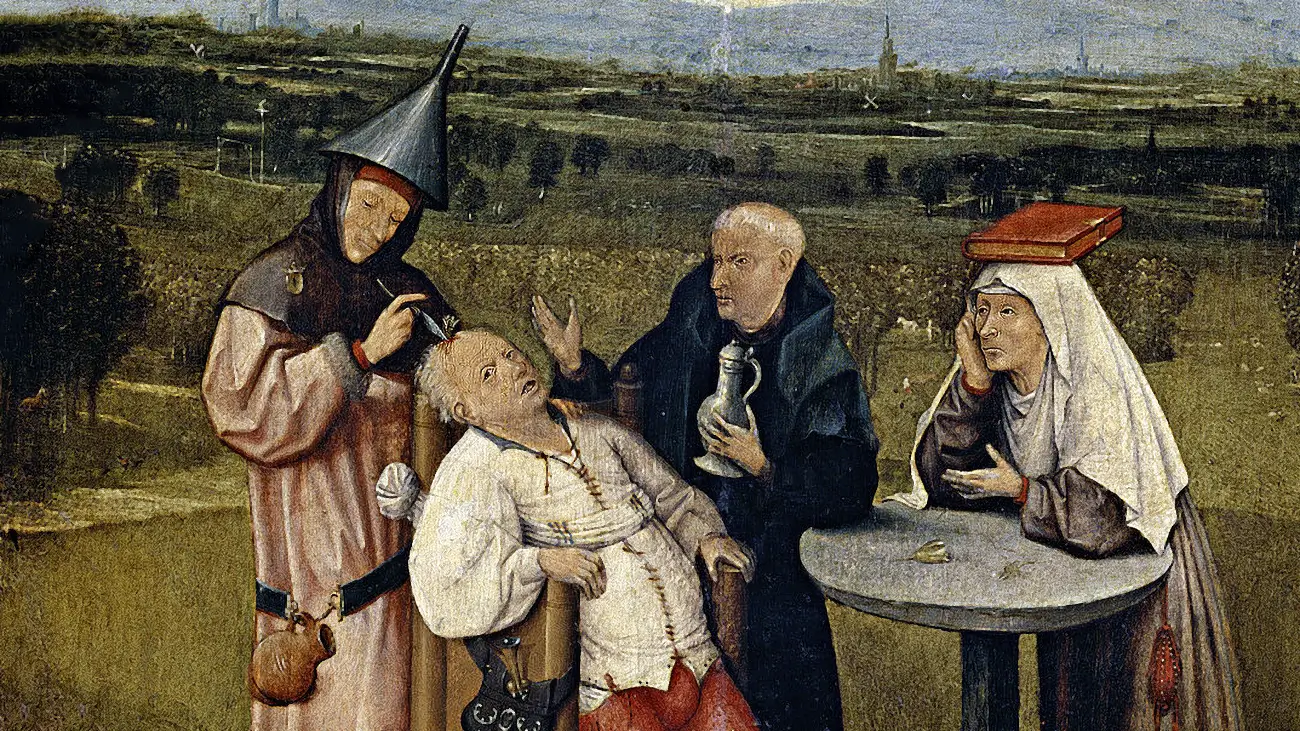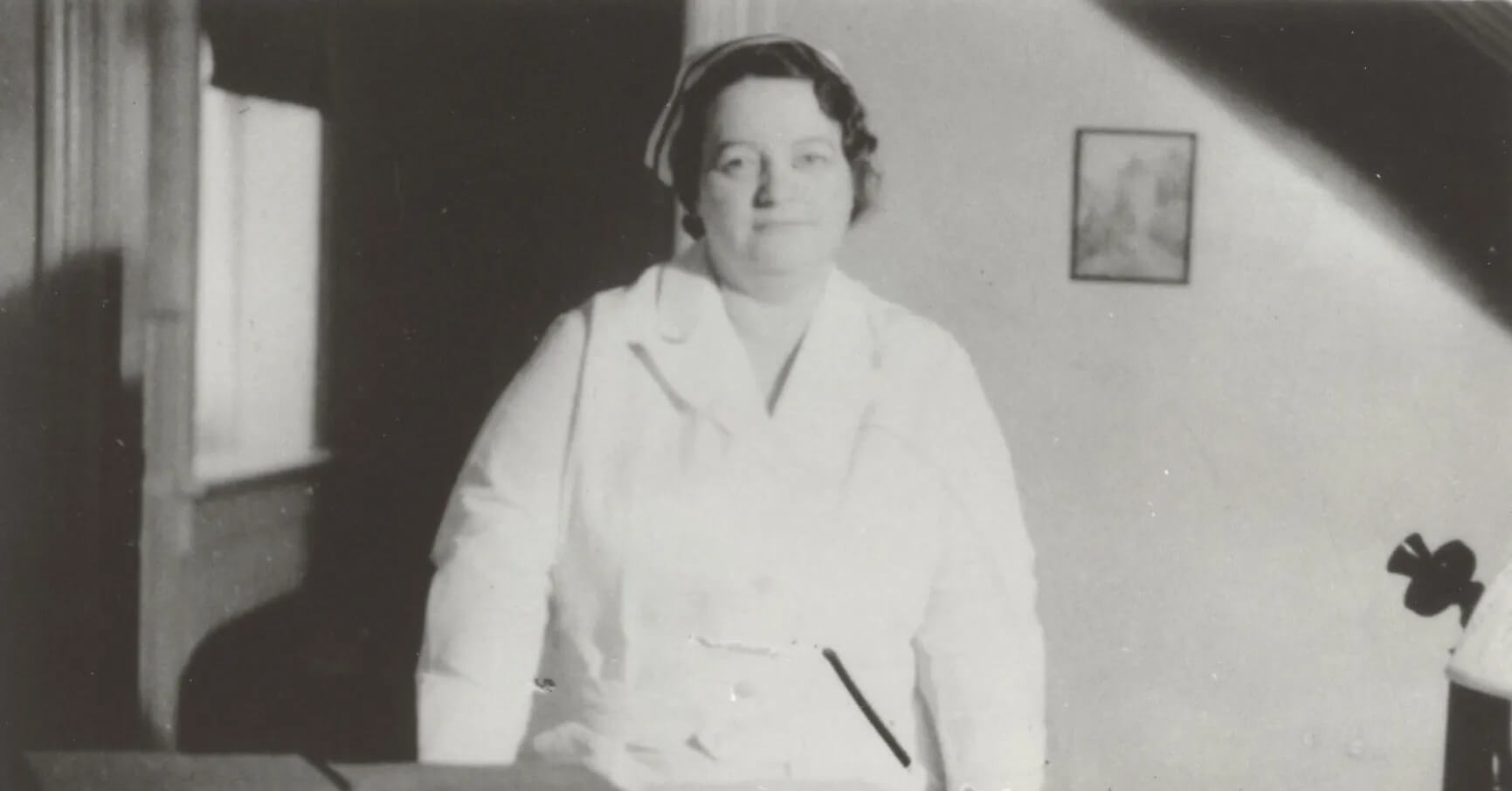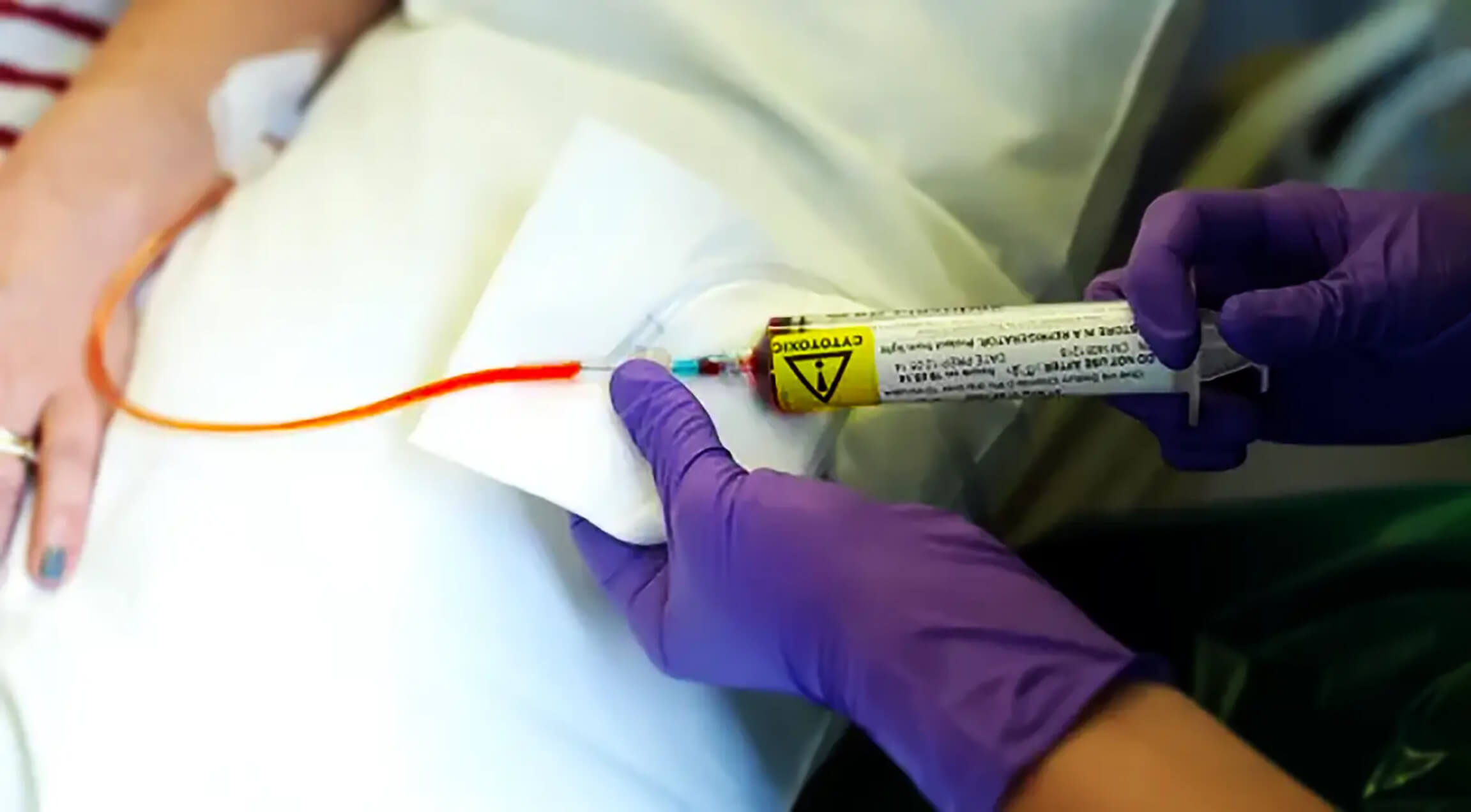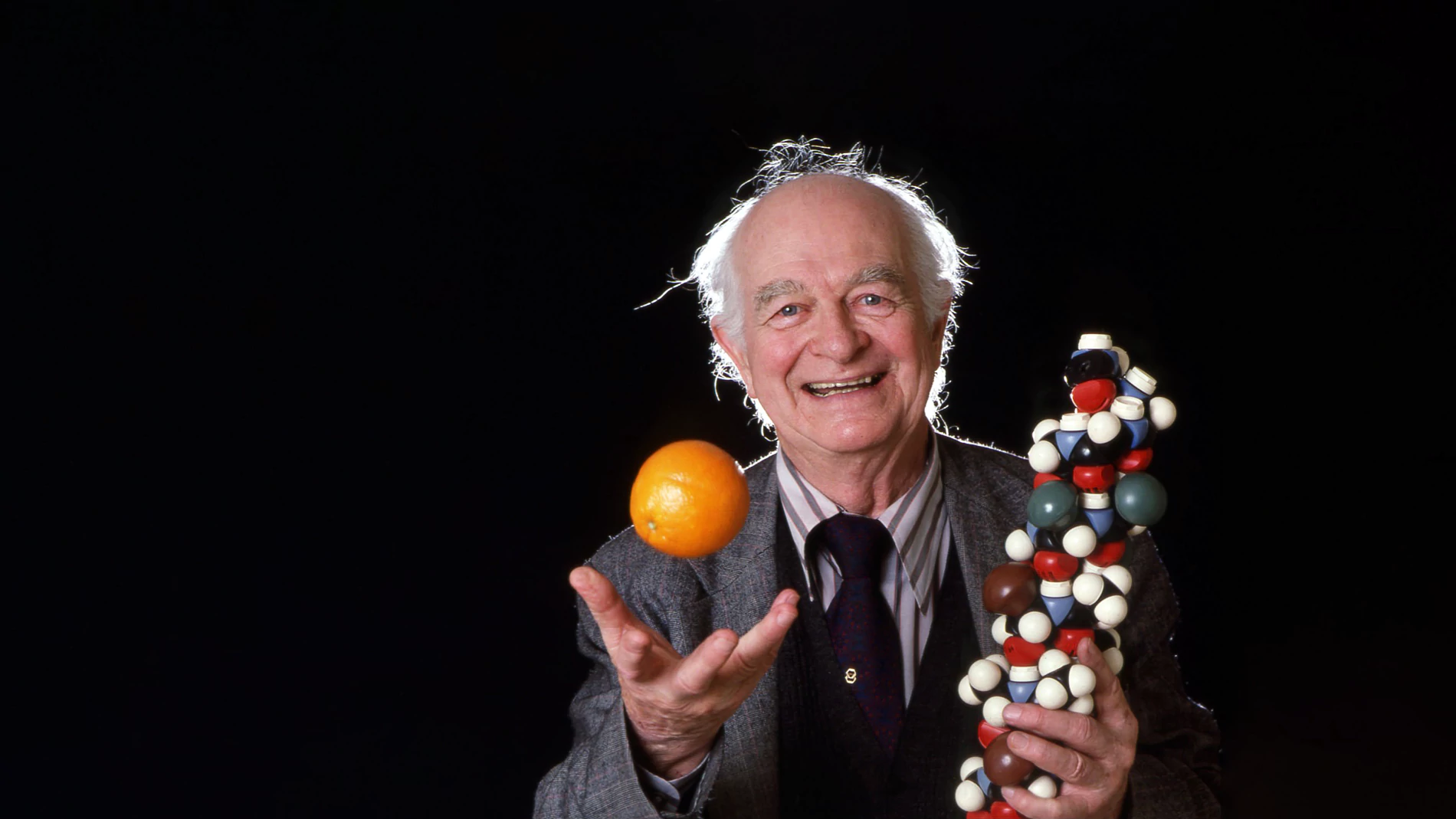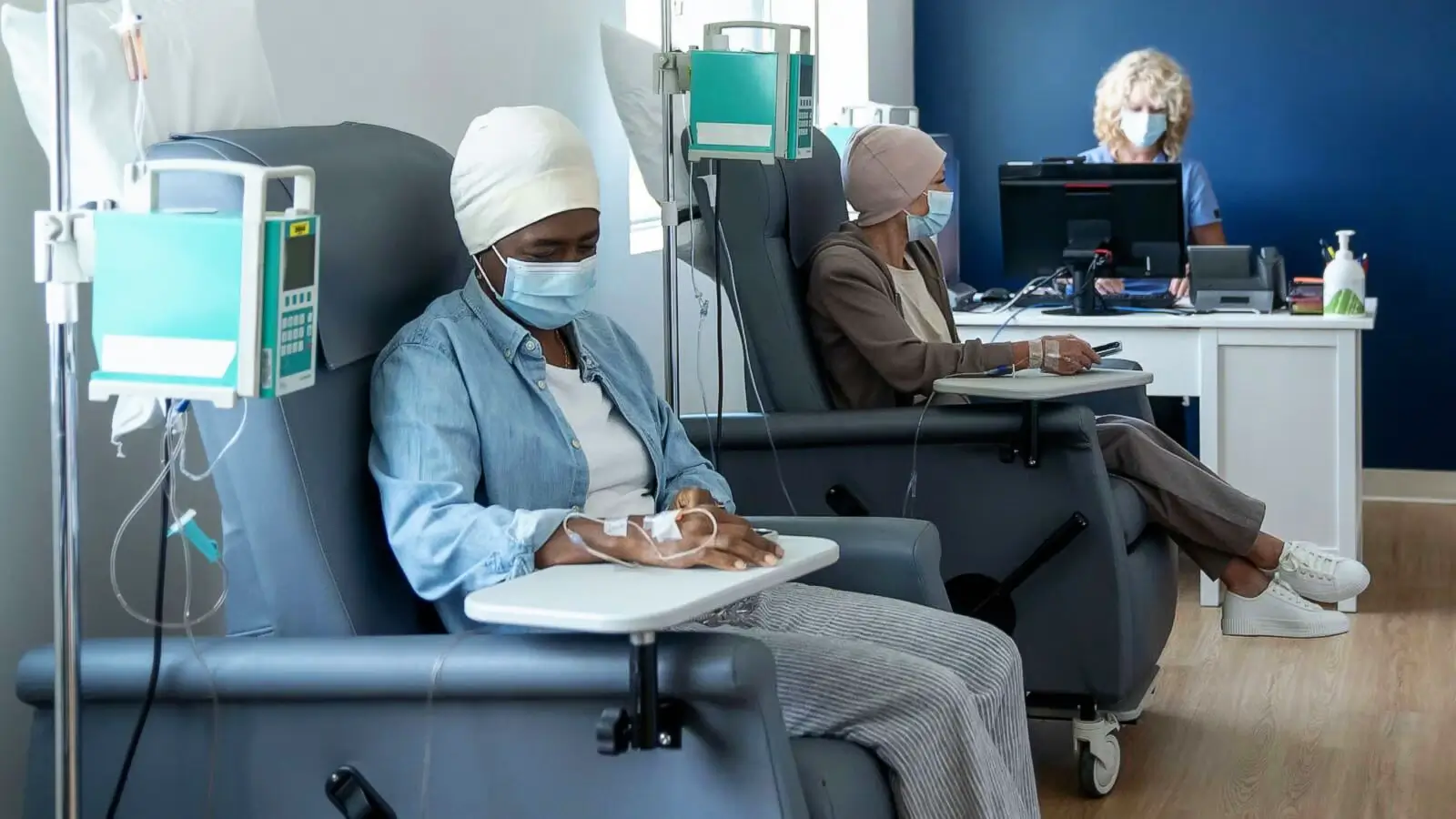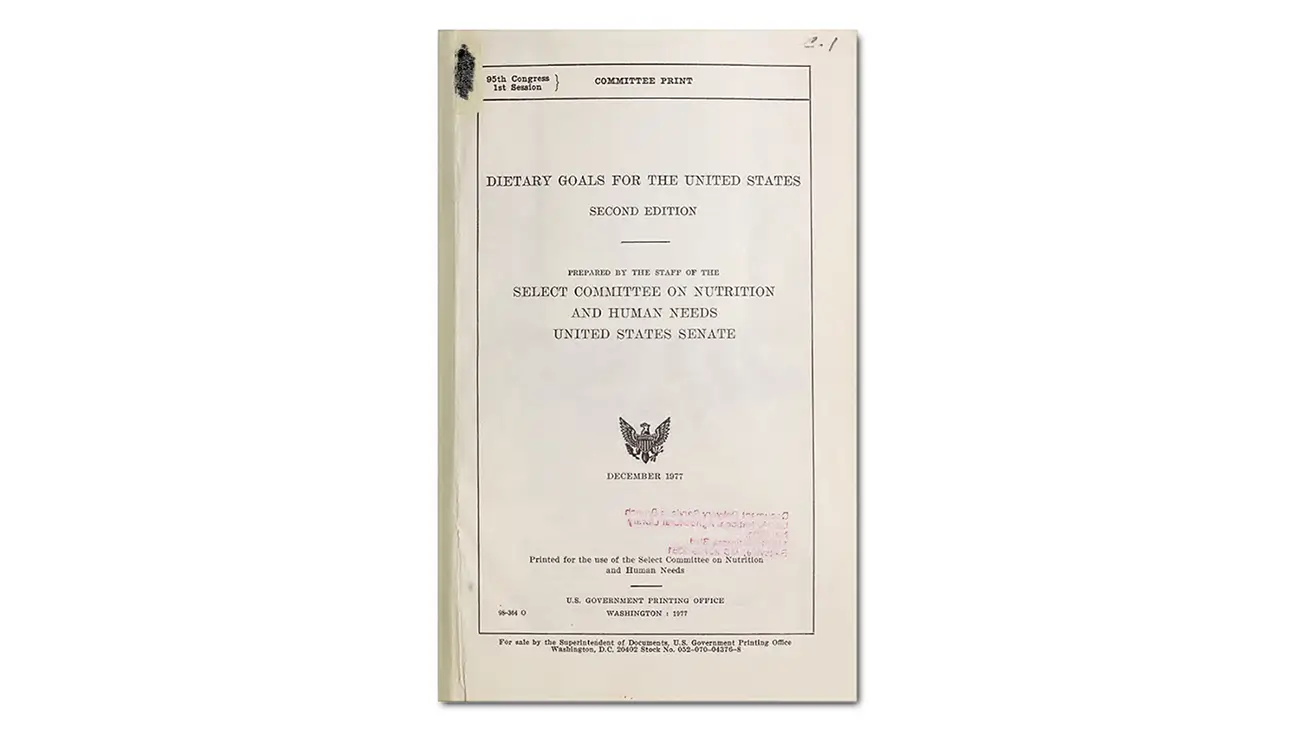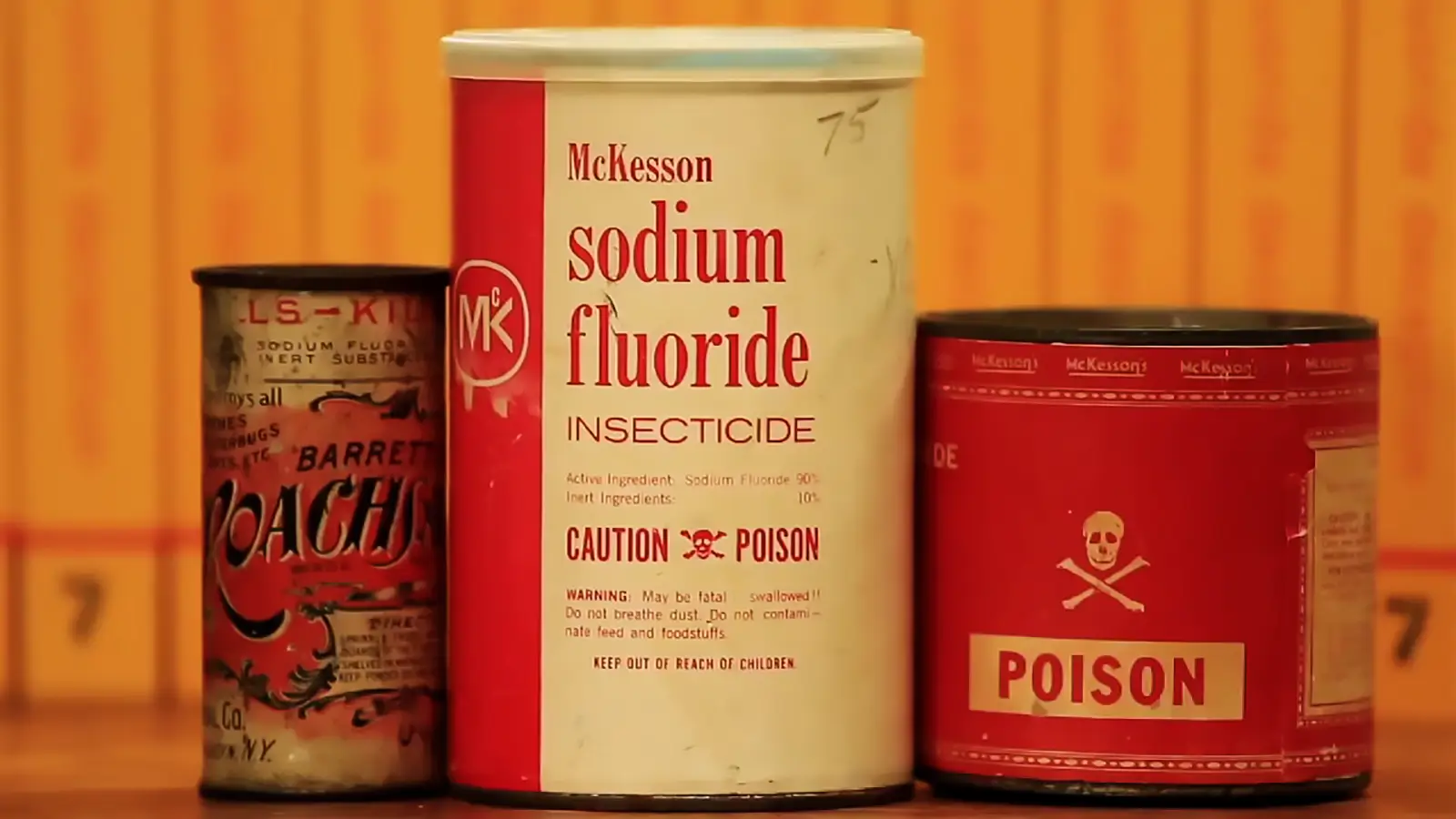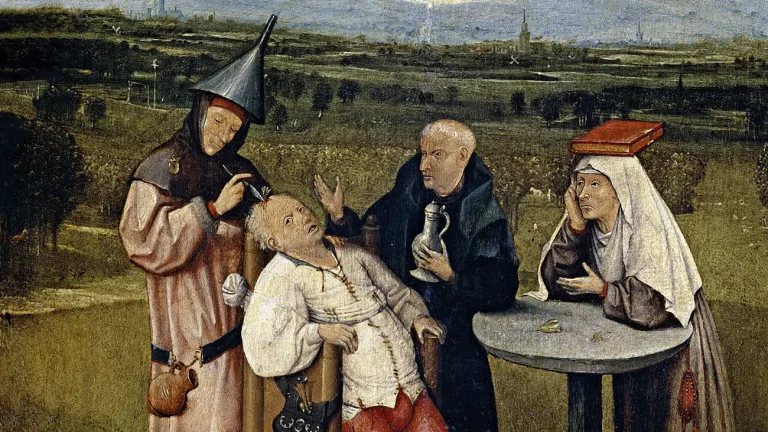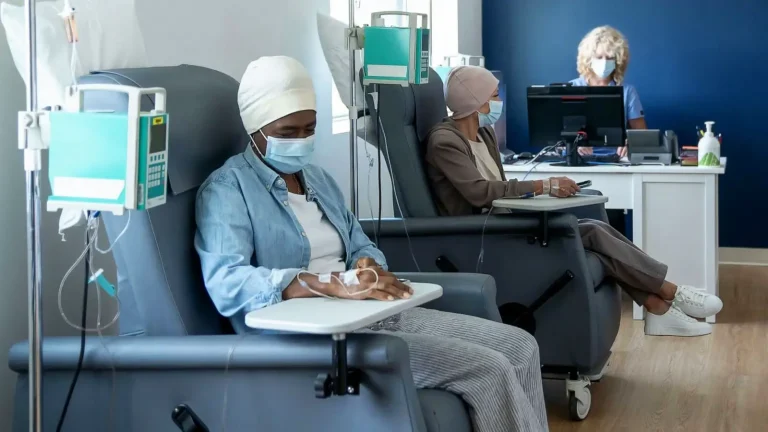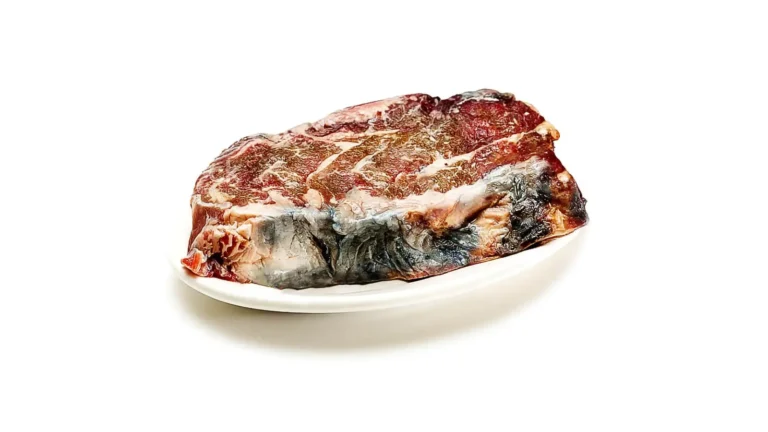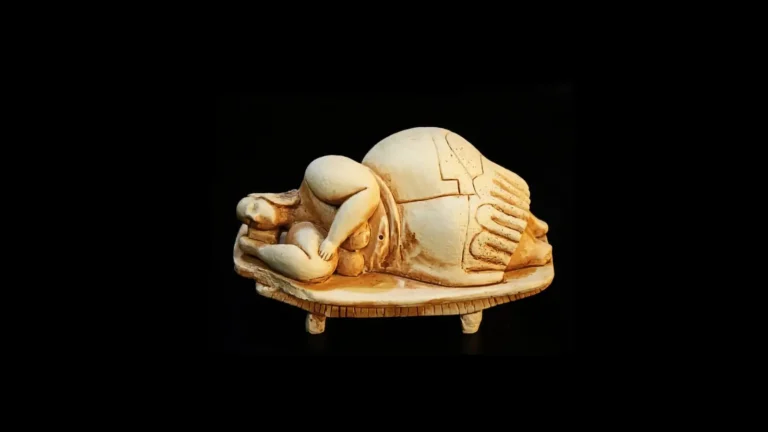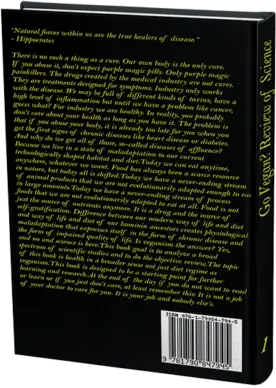Cancer, The Forbidden Cures- Krebiozen
It is highly likely that powers at high places influenced by the reputation of Dr. Ivy believed that he did actually have something in Krebiozen.
Milos Pokimica
Written By: Milos Pokimica
Medically Reviewed by: Dr. Xiùying Wáng, M.D.
Updated September 2, 2023In 1944, a Yugoslavian refugee doctor, Dr. Stevan Durovic, a former assistant professor at the University of Belgrade established the Instituto Biologica Duga in Buenos Aires. He observed that horses with neck tumors caused by a fungus often died, but some would recover.
He theorized that the survivors must have a better immune system that produces some substance that helped them overcome the disease. He experimented and allegedly came up with a process for extracting that substance. It was tested allegedly in dogs with great success.
In 1949 an Argentine businessman Loretani introduced Dr. Durovic to two other businessmen, Ed Moore, and Kenneth Brainard, who proposed an idea for Durovic to go to the USA and meet with Dr. Ivy. Dr. Andrew C. Ivy, was a medical researcher of impregnable reputation and gigantic stature in his profession. Dr. Ivy was vice president of the University of Illinois, head of its huge Medical School, Executive Director of the National Advisory Cancer Council, and he was also director of the American Cancer Society. An important, respected, honored man and the man that will be hard to name as a quack.
So in 1949, he brought to the United States a substance named Kositerin (not Krebiozen), apparently beneficial in the therapy of hypertension. He contacted in Chicago, Dr. Roscoe Miller of Northwestern University. He intended that Kositerin is tested in high blood pressure patients. Presumably, the test for that substance was negative. Later, Dr. Miller introduced Dr. Durovic to Dr. Andrew Ivy. Having come with Kositerin for hypertension, Dr. Durovic just happened to have available for him also the 2000 mg of material he stated came from the blood of horses that had been inoculated with Actinomyces bovis that showed good results in fighting cancer.
Dr. Ivy found the idea attractive. Idea fitted with the views he held on chemical substances that must be present in the body to control the growth of tumors. Indeed, the basic concept that there must be internal control of the growth of tumors by the immune system is shared by many and proven to be correct by research. The immune system does have some ability to fight cancer cells, and we all have cancer cells all the time just our immune system is good enough to keep them in control. Dr. Ivy became interested in the theory shown by Dr. Durovic’s substance.
He decided to test it in a scientific manner. The results were positive supposedly.

Though Krebiozen was used only on persons who had been diagnosed as hopeless and close to death, and many controversies surrounding the case we today cannot know what real effect this drug had if any. Allegedly there was a lessening or complete disappearance of pain, and in many cases, tumors were dissolved and replaced with healthy tissue. Dr. Ivy testified at his trial that without repeating the experiments, without previously having heard of Dr. Durovic as a scientist, without having seen analyses or manufacturing records, or without knowing what was in the ampules, except for Dr. Durovic’s word, he proceeded.
After first injecting himself, Dr. Krasnow, and one dog, and without it occurring to him (he testified) that the alleged substance X might be a hoax, Dr. Ivy injected the first patient on August 20, 1949. Colleagues and physicians continued the clinical trial. In 1951, Dr. Ivy after the research had been done chose to publish his findings. There was a press conference held in the Drake Hotel. It was a close conference where the science writers of four Chicago papers, the Mayor of Chicago, two United States Senators, and potential financial supporters were invited, in addition to some physicians.
Dr. Ivy testified that after testing on 22 patients and seeing beneficial results in 70%, a small private meeting was to be held at the Drake Hotel in Chicago.
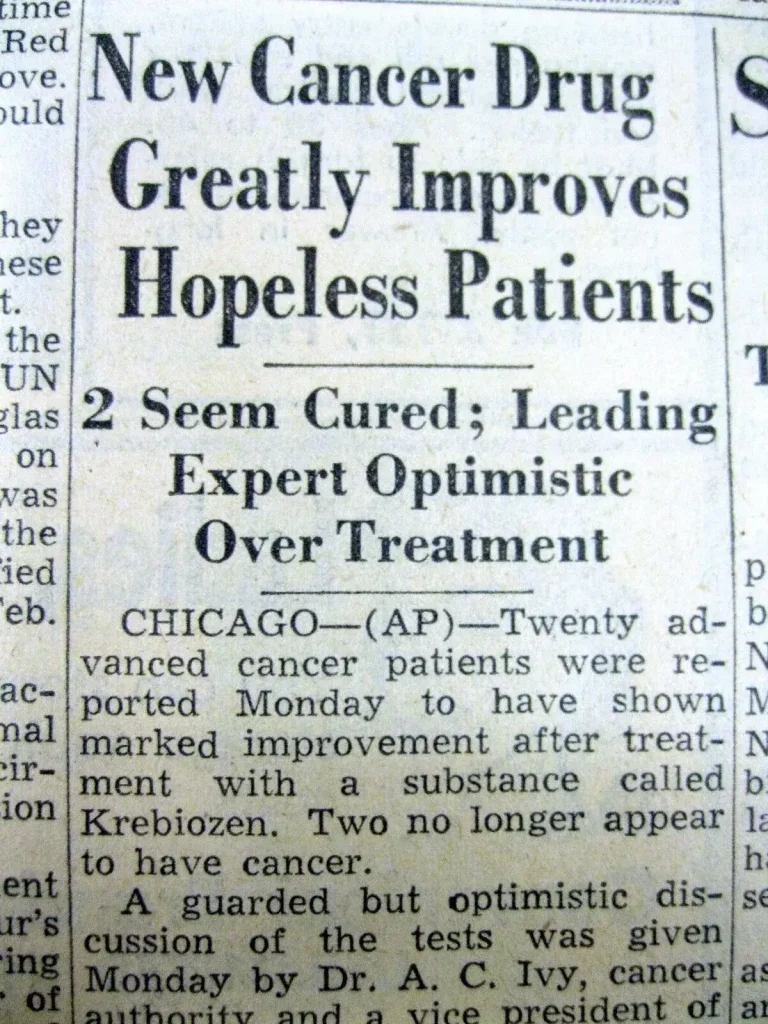
In his words, the idea was to find other scientists and clinics who would further the research effort. Eighty cancer specialists and doctors, and four respected medical journalists were invited. Unfortunately, the public was sent out an unauthorized, sensationalist press release talking about patients who had been cured of cancer. Allegedly Dr. Ivy was horrified, but that did not change the fact that it was more in the line of a marketing campaign business gathering than a real scientific meeting. Results on 22 patients were presented. Of the 22, eight were dead, according to the table in a booklet distributed at the meeting, but not a single instance was cancer listed as the cause of death. In each of the eight instances, however, as was brought out at the trial, the patient died with and of cancer.
Furthermore, two more of the 22 patients had died, one seven days and one two days before the meeting, both from cancer. The description in summary still stood as:
“Dramatically clinical improvement. Now working all day without opiates. The patient had to be carried, couldn’t walk.”
Over the ensuing years, there were lots of patients treated with Krebiozen. In the report on Krebiozen 79.5% of doctors who did try Krebiozen have been discouraged after a single patient: they only treated one. Ninety-two percent treated no more than two patients. The Krebiozen Research Foundation, however, claimed objective improvement with a decrease in tumor size in 61% of tumors of the brain and spinal cord, 70% of metastases to the brain, 48% of breast cancers. Three cases will later suffice to indicate the glaring inadequacy of critical assessment of patient records by the Krebiozen Research Foundation, but at the end of the day, this substance is not relevant at all.

What is important is to understand the system and that is why I use this story as an example.
With such merchandise as a cancer cure, humanitarian considerations are joined by power, influence, and control.
It is highly likely that powers at high places influenced by the reputation of Dr. Ivy believed that he actually did have something in Krebiozen and was scared for their interest and decided to act.
This is why two Chicago businessmen tried to get control of the distribution rights to Krebiozen. Same as Essiac same as any other story. They offer a bribe if not you are done. When they were refused, they threatened to ruin Krebiozen and everyone connected with it. One of the men who made this threat was the friend of J. J. Moore, the treasurer of the American Medical Association.
Even by February 1950 already Moore and Brainard were demanding the distribution rights to the drug, but Dr. Durovic felt it was not proper because of their lack of expertise in this field and they were offered a royalty or partnership, but they reportedly refused all alternatives. AMA officials, Dr. Wermer and Dr. Moore visited Dr. Durovic. At one point reportedly they said to him:
“Don’t you think you have an obligation to Moore and Brainard for the distribution rights to Krebiozen? You must give the distribution rights to Moore and Brainard.”
All of this was written in sworn testimony a year later, and you can do your own investigation. Testimony is publicly still available. Later in 1951, Loretani, who was a businessman from Argentina, met with the Durovic again. He made perfectly clear that:
” If they did not get what they demanded, his powerful friend Dr. Moore would see that they, Dr. Ivy, and their discovery Krebiozen would be utterly destroyed.”
Loretani told Durovic that Ed Moore had a good connection at the University of Illinois who would make an unfavorable report on Krebiozen. They were willing to hand over $2.5 million, and then all attacks would cease. In a meeting between Pick and Wermer, Pick testified that he was told:
“It is too bad a man of your caliber has to go down with the ship, but that is the way it has to be.”
In October 1951, The AMA’s study on Krebiozen was written in only six weeks. Usually, it takes two years or more for such a study. It was done on 100 patients of whom 98 showed no evidence of improvement. A few weeks later Dr. Ivy was put on trial by the Executive Committee of the Chicago Medical Society for breaking medical ethics and was suspended. This forced him to resign from all his medical posts.
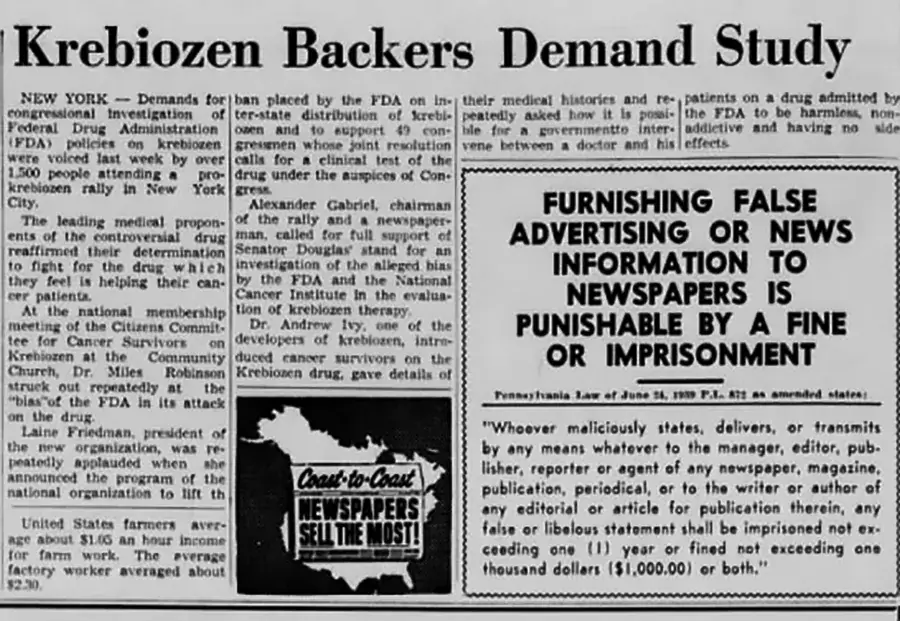
Soon after that, the National Research Council wrote a letter published in the AMA Journal which said there was “no proof of palliative effect” attributable to Krebiozen. So far so good and this story would be forgotten by now.
However, Commodore Barreira, who had been looking after Dr. Durovic’s laboratory in Buenos Aires, was skeptical of the negative AMA report.
He made a plan.
He with his secretary acquired a meeting with Dr. J.J. Moore, the AMA operative. The plan was that Barreira to pretend to have had a falling out with Dr. Durovic and to possess documents that were incriminating against him.
Trusting Barreira’s story, Dr. Moore, keen to get hold of these documents revealed AMA conspiracy for obtaining distribution rights to the drug. He even invited Mr. Barreira to become a partner in the scheme and affirmed to him the AMA would maintain its pressure until Durovic was overpowered and forced to sell out for scrap.
Then, the plotters behind the AMA as rightful owners of Krebiozen would share the millions the drug was worth. Dr. Moore further said Dr. Ivy remained unreasonable in defense of Krebiozen. The conspirators had made him expelled from the Chicago Medical Society, and are going to have him turned out of his office at the University of Illinois.
Mr. Barreira now had proof of all of the corruption and conspiracy.
The conspiracy was discovered at the highest level of AMA, and with this proof, Barreira influenced the Illinois legislature to proceed with the investigation. Hearings opened in April 1953. Commodore Barreira gave his affidavits and testimony.
The AMA during the investigation and afterward have never denied the action of their Treasurer. So did Dr. Moore himself.
Reread this sentence again.
The AMA has never denied the action of their Treasurer nor did Dr. Moore himself.
You want proof of a deep state.
Here you have it.
Dr. Ivy destroyed the AMA Status Report, using words such as deception, falsification, misleading, unethical, and fakery. The Hearings ended nearly a year later. They reported that Dr. Ivy’s research had been conducted according to necessary scientific standards.
There were never make any conspiracy charges against Dr. Moore because their remit only pertained to the goings on at the University.
Reread this again.
The legislators never did make any, !
zero, !
no what so ever !
conspiracy charges !
against Dr. Moore !
because their remit is only concerned with the goings on at the University and that is a lie.!!!!
They did not because that would prove the criminal conspiracy at the level of the American government involving an entire medical system of the USA. !!!!!!!
Unfortunately, the Hearings appeared to change nothing. Later except going to jail, they voted Dr. Moore back in as Treasurer.
The National Cancer Institute declined to examine Krebiozen. Dr. Ivy’s position as Vice President of the University of Illinois was not renewed. All of the medical and other journals rejected to write his research papers. The community was very excited about Krebiozen, and individuals who know about the drug sometimes asked their doctors to use the drug. However, all the studies show that it had no positive effect and there were reports from hospitals that they tested it and that it was worthless. One doctor from Sloan Kettering Memorial Hospital, New York, even wrote in a letter that: “we tried it on 100 patients”.
The only problem was that it was later found to be a lie. Some doctors also reported that their patients had died after using Krebiozen. The FDA supposedly did its own research, and the finding was that Krebiozen was only creatine, and then announced plans to prosecute Dr. Ivy and Dr. Durovic.
Again the only problem was that in an actual trial that followed, FDA experts admitted they were “mistaken.”
Today at any official place we would find that Krebiozen was just creatine, but again it was proven to be a “mistake.”
In this case, you can see the scope of corruption. It was not a mistake it was an organized effort for gaining or maintaining control of the medical industry. When FDA experts admitted, they were mistaken that part of the sentence you would not read on Wikipedia.
That part has been forgotten.
Here is the actual “story” they are pushing at the FDA website to this day with the image of creatine that was proven to be a “mistake” in court hearings, https://www.fda.gov/about-fda/fda-history-exhibits/alma-levant-haydens-contributions-regulatory-science
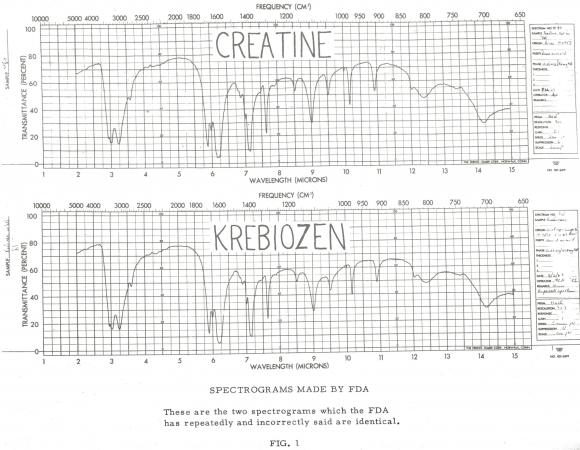
If it seems impossible that a “distinguished” cancer center would lie, please remember that Sloan Kettering was caught red-handed lying about different cancer therapy, Laetrile, and was exposed by one of its own employees, Dr. Ralph Moss, who was unwilling to participate in the fraud.
The details of correspondence between three Sloan-Kettering cancer specialists and Mrs. Dorothea Seeber on behalf of a friend in the last stages of cancer are one typical example. Sloan-Kettering doctors and their view of Krebiozen can be seen in a letter sent to people who ask about it and whether it would be advisable to use it on a “hopeless case.”
“We tried it (Krebiozen) on 100 patients, and I regret to say that we could not substantiate any of the claims ascribed to its use.”
“I have had only a few patients who have been tried on Krebiozen, and there was no improvement in their condition.”
A third wrote:
“A considerable amount of work has been done on this drug and we found it is absolutely worthless.”
An affidavit by Dr. Ivy tells a different story in which under oath you can read that he never provided or that these three doctors even ever received any of the drugs. Until the date of the affidavit, not one ampoule of Krebiozen had ever been sent to the Sloan-Kettering Institute. Then the new FDA laws came into effect in June 1963, which meant that Krebiozen could not be sent over state lines without FDA approval, and of course, they had no intention of ever granting it. So, the substance could only be purchased in Illinois until 1973 when it was outlawed in Illinois too.
The dealings that come out in public associated with this story are of dramatic proportions.
There are falsified medical reports, South American undercover agents, threats of deportation, monitored phone calls, and charges of influence by the Vatican.
To illustrate this a reporter on the staff of the New York Post called the A.M.A. for specific answers to specific questions, such as:
“Does J. J. Moore deny that he formed a conspiracy to gain control of Krebiozen?”
Also:
“Does the A.M.A. deny that its official report against Krebiozen was falsified?”
and was only met with this stock answer:
“The A.M.A. will not answer specific questions concerning Krebiozen.”
The reporter’s s comment was:
“It sounds a bit like the A.M.A. is pleading the Fifth Amendment.”
Krebiozen was just another unproven probably ineffective treatment, but that is irrelevant. Powers at be did not care and saw it just as another threat to their control. It is completely irrelevant what that drug was or whether was it effective. This case had proven in the court of law and also in the congressional hearings the true nature of medical and governmental corrupted reality, and if you do not want to see it, then that is your choice.
If you have done much reading about alternative cancer treatments, you are aware there are a great number of therapies with stories similar to this. And that are just the ones that we know about.
What would have happened if they decided to take the 2,5 million?
They were greedy like any other doctors out there, and they thought that they could get much more out of it, but they underestimated and probably didn’t understand the level of corruption.
Cancer quackery is lucrative. Dr. Stevan Durovic was under indictment for evasion of income tax in the amount of $904,907 for the years 1960, 1961, and 1962 alone. Government investigators had shown at his trial that large sums of money were withdrawn from the bank accounts of the Promak Laboratory, money derived from the sale of Krebiozen and sent to Canadian and Swiss banks. However, Dr. Durovic did manage to get out. Or was allowed to. He told a Chicago reporter that he had flown nonstop from Chicago to London and then traveled to Paris. Internal Revenue agents told a Washington correspondent, however, that Durovic had flown from Miami to Bimini in the Bahamas, from Bimini to Nassau, from Nassau to Bermuda, and from Bermuda to London and from London to Paris. One of Durovic’s attorneys has even filed a suit seeking $11,787 in unpaid legal fees.
The problem here is how many other people did find something similar that actually did work against cancer but decided that they would take the bribe and go away peacefully.
That is a rational choice.
I would say nine out of ten. For every Krebiozen that we know, there is nine other that are suppressed.

References:
Passages selected from a book: Pokimica, Milos. Go Vegan? Review of Science Part 2. Kindle ed., Amazon, 2018.
Related Posts
Do you have any questions about nutrition and health?
I would love to hear from you and answer them in my next post. I appreciate your input and opinion and I look forward to hearing from you soon. I also invite you to follow us on Facebook, Instagram, and Pinterest for more diet, nutrition, and health content. You can leave a comment there and connect with other health enthusiasts, share your tips and experiences, and get support and encouragement from our team and community.
I hope that this post was informative and enjoyable for you and that you are prepared to apply the insights you learned. If you found this post helpful, please share it with your friends and family who might also benefit from it. You never know who might need some guidance and support on their health journey.
– You Might Also Like –

Learn About Nutrition
Milos Pokimica is a doctor of natural medicine, clinical nutritionist, medical health and nutrition writer, and nutritional science advisor. Author of the book series Go Vegan? Review of Science, he also operates the natural health website GoVeganWay.com
Medical Disclaimer
GoVeganWay.com brings you reviews of the latest nutrition and health-related research. The information provided represents the personal opinion of the author and is not intended nor implied to be a substitute for professional medical advice, diagnosis, or treatment. The information provided is for informational purposes only and is not intended to serve as a substitute for the consultation, diagnosis, and/or medical treatment of a qualified physician or healthcare provider.NEVER DISREGARD PROFESSIONAL MEDICAL ADVICE OR DELAY SEEKING MEDICAL TREATMENT BECAUSE OF SOMETHING YOU HAVE READ ON OR ACCESSED THROUGH GoVeganWay.com
NEVER APPLY ANY LIFESTYLE CHANGES OR ANY CHANGES AT ALL AS A CONSEQUENCE OF SOMETHING YOU HAVE READ IN GoVeganWay.com BEFORE CONSULTING LICENCED MEDICAL PRACTITIONER.
In the event of a medical emergency, call a doctor or 911 immediately. GoVeganWay.com does not recommend or endorse any specific groups, organizations, tests, physicians, products, procedures, opinions, or other information that may be mentioned inside.
Editor Picks –
Milos Pokimica is a health and nutrition writer and nutritional science advisor. Author of the book series Go Vegan? Review of Science, he also operates the natural health website GoVeganWay.com
Latest Articles –
Top Health News — ScienceDaily
- This weight loss option beats Ozempic by 5 timeson January 7, 2026
Bariatric surgery far outperformed GLP-1 weight loss drugs in a new real-world comparison of more than 50,000 patients. Two years after treatment, surgery patients lost about 58 pounds on average, while those using semaglutide or tirzepatide lost roughly 12 pounds. Even patients who stayed on GLP-1 drugs for a full year saw much smaller results than surgical patients. High dropout rates and real-world challenges appear to blunt the drugs’ effectiveness.
- Japanese scientists just built human brain circuits in the labon January 7, 2026
Researchers in Japan built a miniature human brain circuit using fused stem-cell–derived organoids, allowing them to watch the thalamus and cortex interact in real time. They found that the thalamus plays a decisive role in maturing the cortex and organizing its neural networks. Signals from the thalamus triggered synchronized activity in specific neuron types, while others remained unaffected. The system closely mimics human brain development and could transform how scientists study […]
- Ancient skeletons reveal viruses embedded in human DNAon January 7, 2026
Researchers have reconstructed ancient herpesvirus genomes from Iron Age and medieval Europeans, revealing that HHV-6 has been infecting humans for at least 2,500 years. Some people inherited the virus directly in their DNA, passing it down across generations. The study shows that these viruses evolved alongside humans—and that one strain eventually lost its ability to integrate into our chromosomes. It’s the first time this long, intimate relationship has been proven with ancient genetic […]
- Magnetic nanoparticles fight bone cancer and help healingon January 7, 2026
Researchers have developed a magnetic nanomaterial that can kill bone cancer cells and support bone regeneration at the same time. The material heats up under a magnetic field to destroy tumors, while its bioactive coating helps it bond to bone and stimulate healing. Tests showed rapid formation of bone-like minerals, a key sign of successful integration. The breakthrough could lead to smarter, less invasive treatments for bone tumors.
- A global cancer surge is underway and the world is not readyon January 7, 2026
Global cancer cases have surged dramatically, doubling since 1990 and reaching 18.5 million new diagnoses in 2023. Deaths have also climbed to over 10 million a year, with the steepest increases hitting low- and middle-income countries. Without urgent action, researchers project more than 30 million new cases annually by 2050. Alarmingly, around four in ten cancer deaths are tied to preventable risks such as smoking, poor diet, and high blood sugar.
- Wildfires are polluting the air far more than thoughton January 7, 2026
Scientists have discovered that wildfires release far more air-polluting gases than previously estimated. Many of these hidden emissions can transform into fine particles that are dangerous to breathe. The study shows wildfire pollution rivals human-made emissions in some parts of the world. This helps explain why wildfire smoke can linger and worsen air quality long after the flames are gone.
- The simplest way teens can protect their mental healthon January 7, 2026
Teens who sleep in on weekends may be giving their mental health a boost. A new study found that young people who made up for lost weekday sleep had a significantly lower risk of depression. While consistent sleep is still best, weekend catch-up sleep appears to offer meaningful protection. The findings highlight how powerful sleep can be for adolescent well-being.
PubMed, #vegan-diet –
- Exploring Experiences and Practices of Contemporary Vegans in Australia: A Qualitative Studyon January 7, 2026
CONCLUSIONS: Nutrition interventions supporting individuals to adopt plant-based dietary patterns are more likely to be successful if compelling benefits are articulated and reinforced. Quality information about overcoming practical challenges is required. However, long-term adherence is more likely if psychosocial resilience is supported.
- Response to Letter to the Editor: Iron, zinc, and iodine in vegan youthon January 4, 2026
No abstract
- Impact of alpha-linolenic acid supplementation on long-chain n-3 fatty acid profiles in Western, flexitarian, vegetarian, and vegan dietson December 31, 2025
CONCLUSION: In conclusion, flaxseed oil supplementation combined with a controlled diet effectively improves n-3 LCPUFA status irrespective of habitual diet. The extent of relative improvement was primarily determined by baseline EPA concentrations.
- Vegetarian Dietary Patterns for Adults: A Position Paper of the Academy of Nutrition and Dieteticson December 31, 2025
It is the position of the Academy of Nutrition and Dietetics that, in adults, appropriately planned vegetarian and vegan dietary patterns can be nutritionally adequate and can offer long-term health benefits such as improving several health outcomes associated with cardiometabolic diseases. Vegetarian dietary patterns exclude meat, poultry, and seafood, and vegan dietary patterns exclude all foods of animal origin. Registered dietitian nutritionists (RDNs) and nutrition and dietetics…
- Academy of Nutrition and Dietetics’ Vegetarian Position Paper Mistakenly Links Vegetarian and Vegan Diets with Vitamin D Deficiencyon December 31, 2025
No abstract
Random Posts –
Featured Posts –
Latest from PubMed, #plant-based diet –
- Exploring Experiences and Practices of Contemporary Vegans in Australia: A Qualitative Studyby Linda Smillie on January 7, 2026
CONCLUSIONS: Nutrition interventions supporting individuals to adopt plant-based dietary patterns are more likely to be successful if compelling benefits are articulated and reinforced. Quality information about overcoming practical challenges is required. However, long-term adherence is more likely if psychosocial resilience is supported.
- Ancient biomolecules suggest a learned foraging strategy in extinct cave bearsby Ioana N Meleg on January 7, 2026
Studying the behavioral ecology of long-extinct species is challenging due to the difficulty in measuring the behavioral phenotype and correlating this with genetic and environmental factors. However, a multidisciplinary approach integrating isotope analysis of diet and ancient DNA analysis of genetic relationships offers a potential framework to test the proximate causes of dietary preferences. Our study focuses on Late Pleistocene cave bears from the Romanian Carpathians. Stable isotope…
- Indigenous Comprehension of Fodder Trees and Shrubs in Semiarid Areas of Metema District, Northwestern Ethiopiaby Yirgalem Melkamu on January 7, 2026
CONCLUSIONS: This study revealed that the indigenous communities of Metema District possess high knowledge of tree and shrub fodder plants. The plants are vital components of their livestock feeding systems to improve their livelihoods.
- Parent Perspectives on the Interactive Role of Charitable and Federal Nutrition Assistanceby Cristina M Gago on January 6, 2026
CONCLUSIONS: The experiences of pantry users with children underscore the need to reinvest in charitable and federal nutrition assistance programs, broaden the eligibility criteria, and alleviate the administrative burden associated with federal nutrition program access.
- Enhancing Gluten-Free Cake Quality With Germinated and Ungerminated Mung Bean Flours: A Comparative Analysisby Sultan Acun on January 6, 2026
Gluten-free (GF) baked products are often constrained by limited nutritional quality and a lack of bioactive compounds. This study investigates the incorporation of germinated mung bean flours (GMBF) and ungerminated mung bean flours (UMBF) into GF cake formulations as partial (50%) or complete (100%) substitutes for rice flour. Comprehensive analyses were conducted on both cakes and raw flours, including proximate composition, total phenolic content (TPC), antioxidant activity…
- Quality-oriented diet therapy for chronic kidney diseaseby Juan J Carrero on January 6, 2026
Traditional dietary advice for people living with chronic kidney disease (CKD) focused predominantly on the quantity of energy and protein provided by the diet as well as restricting the consumption of single micronutrients. However, flaws in the assumptions that underlie this quantity-based approach have led to re-examination of medical nutrition therapy for kidney-related conditions, with a shift towards recommending more varied and liberalized plant-rich diets with a focus on dietary […]

